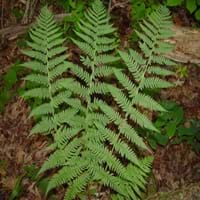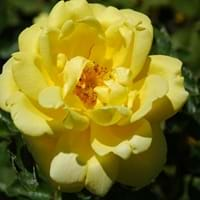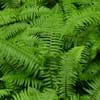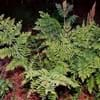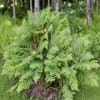Life Span
Perennial
Perennial
Origin
Northeastern United States, Mid-Atlantic United States, North-Central United States, Central United States, Canada
Hybrid origin
Types
Not available
Not Available
Habitat
Cliffs, Forests, Rocky areas, Slopes
gardens, Pastures, Prairies, Terrestrial, Tropical regions
USDA Hardiness Zone
3-8
3-8
Sunset Zone
Not Available
1a, 1b, 2a, 2b, 3a, 3b, 4, 5, 6, 7, 8, 9, 10, 11, 12, 13, 14, 15, 16, 17, 18, 19, 20, 21, 22, 23, 24
Habit
Clump-Forming
Oval or Rounded
Flower Color
Non Flowering Plant
Not Available
Flower Color Modifier
Not Available
Not Available
Fruit Color
Non Fruiting Plant
Non Fruiting Plant
Leaf Color in Spring
Light Green, Gray Green
Not Available
Leaf Color in Summer
Blue Green, Dark Green
Not Available
Leaf Color in Fall
Blue Green, Gray Green, Dark Green
Not Available
Leaf Color in Winter
Gray Green, Dark Green
Light Green
Leaf Shape
Compound
Pinnate
Plant Season
Spring, Summer, Fall, Winter
Summer, Fall
Sunlight
Full Shade, Partial shade
Full Sun, Partial Sun
Type of Soil
Clay, Loam
Loam, Sand
The pH of Soil
Acidic, Neutral
Acidic, Neutral
Soil Drainage
Average
Well drained
Bloom Time
Not Available
Early Summer, Summer, Late Summer, Early Fall
Tolerances
Not Available
Drought
Where to Plant?
Ground
Ground, Pot
How to Plant?
Root Division, Spores
Grafting, Stem Planting, Transplanting
Plant Maintenance
Medium
Medium
Watering Requirements
Medium
Form a Soil ring to water efficiently, Requires regular watering, Water twice a day in the initial period, Water when soil is dry
In Summer
Lots of watering
Lots of watering
In Spring
Moderate
Moderate
In Winter
Average Water
Average Water
Soil pH
Acidic, Neutral
Acidic, Neutral
Soil Type
Clay, Loam
Loam, Sand
Soil Drainage Capacity
Average
Well drained
Sun Exposure
Full Shade, Partial shade
Full Sun, Partial Sun
Pruning
Prune to stimulate growth, Remove damaged leaves, Remove dead branches, Remove dead leaves
Prune if you want to improve plant shape, Remove damaged leaves, Remove dead leaves, Remove deadheads, Shape and thin as needed
Fertilizers
All-Purpose Liquid Fertilizer
All-Purpose Liquid Fertilizer, organic fertlizers
Pests and Diseases
Pests and diseases free, Red blotch
Aphids, Bacterial Diseases, Mites, Slugs
Plant Tolerance
Drought
Drought
Flower Petal Number
Single
Not Available
Edible Fruit
No
Not Available
Foliage Texture
Medium
Not Available
Foliage Sheen
Matte
Not Available
Attracts
Not Available
Not Available
Allergy
Skin irritation, Skin rash
no allergic reactions
Aesthetic Uses
Borders, Hanging Basket, Mixed Border, Showy Purposes, Used as an interior landscaping species, Used for decorating walls, fences, gates, hedges, etc.
Beautification, Bouquets
Beauty Benefits
Not Available
Not Available
Environmental Uses
Air purification
Air purification
Medicinal Uses
Not Available
No Medicinal Use
Part of Plant Used
Not Available
Flowers
Other Uses
Used as Ornamental plant, Used for Landscaping
Showy Purposes, Used as Ornamental plant
Used As Indoor Plant
Yes
No
Used As Outdoor Plant
Yes
Yes
Garden Design
Feature Plant, Groundcover, Mixed Border, Rock Garden, Wall
Container, Cutflower, Feature Plant, Foundation, Mixed Border
Botanical Name
DRYOPTERIS marginalis
ROSA 'Allgold'
Common Name
Marginal wood fern
Floribunda Rose
In Hindi
marginal wood fern
रोजा allgold
In German
marginal Holz fern
rosa Allgold
In French
marginal dryoptéride
rosa TousPlaqué
In Spanish
helecho de madera marginal
rosa allgold
In Greek
οριακή φτέρη ξύλο
rosa allgold
In Portuguese
samambaia de madeira marginal
rosa allgold
In Polish
marginalne drewna paproci
rosa allgold
In Latin
Fern marginalibus
Rosa allgold
Phylum
Tracheophyta
Not Available
Class
Filicopsida
Not Available
Order
Polypodiales
Rosales
Family
Dryopteridaceae
Rosaceae
Clade
Not Available
Angiosperms, Eudicots, Rosids
Tribe
Not Available
Not Available
Subfamily
Not Available
Rosoideae
Number of Species
Not Available
Importance of Marginal Wood Fern and Floribunda Rose
Want to have the most appropriate plant for your garden? You might want to know the importance of Marginal Wood Fern and Floribunda Rose. Basically, these two plants vary in many aspects. Compare Marginal Wood Fern and Floribunda Rose as they differ in many characteristics such as their life, care, benefits, facts, etc. Every gardener must at least have the slightest clue about the plants he wants to plant in his garden. Compare their benefits, which differ in many ways like facts and uses. The medicinal use of Marginal Wood Fern is Not Available whereas of Floribunda Rose is No Medicinal Use. Marginal Wood Fern has beauty benefits as follows: Not Available while Floribunda Rose has beauty benefits as follows: Not Available.
Compare Facts of Marginal Wood Fern vs Floribunda Rose
How to choose the best garden plant for your garden depending upon its facts? Here garden plant comparison will help you to solve this query. Compare the facts of Marginal Wood Fern vs Floribunda Rose and know which one to choose. As garden plants have benefits and other uses, allergy is also a major drawback of plants for some people. Allergic reactions of Marginal Wood Fern are Skin irritation and Skin rash whereas of Floribunda Rose have no allergic reactions respectively. Having a fruit bearing plant in your garden can be a plus point of your garden. Marginal Wood Fern has no showy fruits and Floribunda Rose has showy fruits. Also Marginal Wood Fern is not flowering and Floribunda Rose is not flowering . You can compare Marginal Wood Fern and Floribunda Rose facts and facts of other plants too.
